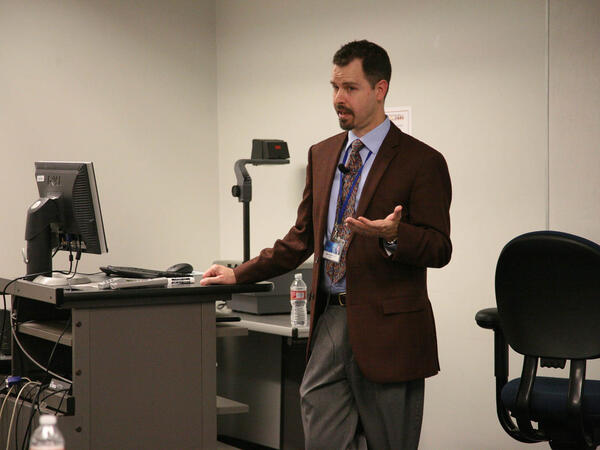
Event report
February 2015 - The Healthy Brain - The Alzheimer's Brain Seminar
The seminar was “sold out” and the room was close to packed when Gary Kleemann introduced Dr. Jay Braun, ASU Emeritus Professor of Psychology. Dr. Braun started his talk with a brief overview of the physiology of the healthy brain, a review of things we all probably learned in ninth grade biology class but have since forgotten. He supplied us with a “cheat” sheet containing basic human brain information and basic brain nomenclature. Two of the many interesting facts about the brain were:
- The brain is just a long hollow tube bundled up in the skull and contains about 100 billion neurons.
- Scans of the brain show that even a simple activity like closing your fist actually causes many parts of the brain to become active, not just the area “assigned” to muscle activity.
The final part of the presentation discussed some of the methods used to monitor the brain and what can be learned from these efforts. PET, positron emission tomography, scans are very helpful because they generate three dimensional images of the brain process unlike CAT, computerized axial tomography, scans which only show shape and location. PET scans can show the change of brain activity over time and are thus helping uncover the role, if any, of plaques, abnormal clusters of protein fragments, and tangles, twisted strands of proteins, in the death of nerve cells in the cerebrum.
Dr. Braun ended his talk with his often stated view: Exercise is the most important thing you can do to maintain a healthy brain.
The second part of the seminar was presented by Bryan Woodruff MD from the Mayo Clinic, Arizona. Dr. Woodruff is also a member of the Clinical Core of the Arizona Alzheimer’s Consortium. In his presentation he addressed six topics:
- Red Flags for Dementia
- What is Dementia?
- Alzheimer’s Facts and Figures
- How is Dementia Diagnosed – a clinical history
- Treatment
- Alzheimer’s pathophysiology
The presentation slides, available at seminar slides, give a broad overview of the talk but much of the detail is not shown on the slides. Look for articles in future Prime Times addressing some of the topics presented in the seminar.
Following are a few of the many interesting points made by Dr. Woodruff:
- Memory is not perfect and memory lapses are a normal part of life. Forgetting why you entered a room or the name of the actor are not by themselves red flags for dementia.
- Establishing a diagnosis of Alzheimer’s disease requires a multi-prong approach. Since memory loss is involved it is critical to have a reliable informant.
- Dr. Woodruff pointed out that Alzheimer's drugs offer one strategy to help manage memory loss, thinking and reasoning problems, and day-to-day function. Unfortunately, Alzheimer's drugs don't work for everyone, and they can't cure the disease or stop its progression. Over time, their effects wear off. Further while any of the three FDA approve drugs, on average, work about equally well, in individuals, one drug may work better or produce fewer side effects than does another.
- Studies of Alzheimer’s brains reveal several pathological problems including: accumulation of abnormal proteins so called plaques and tangles.
- Initiating treatment at the MCI, mild cognitive impairment, stage may be too late. Evidence suggests that there is already significant neurological damage especially the creation of plaques before the outward signs of dementia appear.
Story by Barry McNeill. Photos by Barry McNeill & Dave Scheatzle

